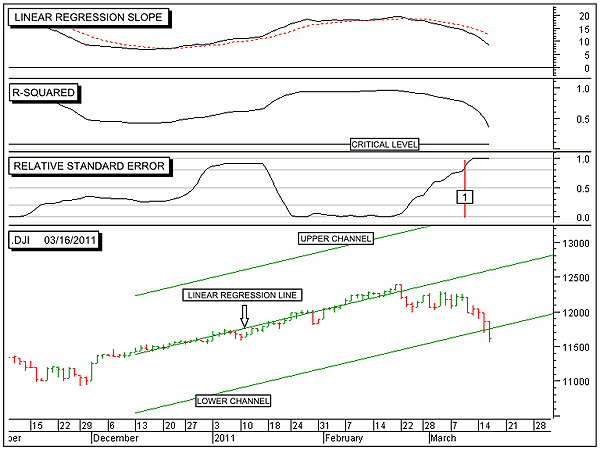
HOT TOPICS LIST
- MACD
- Fibonacci
- RSI
- Gann
- ADXR
- Stochastics
- Volume
- Triangles
- Futures
- Cycles
- Volatility
- ZIGZAG
- MESA
- Retracement
- Aroon
INDICATORS LIST
LIST OF TOPICS
PRINT THIS ARTICLE
by Alan R. Northam
Statistical analysis is used to show the Dow Jones Industrial Average in a new intermediate-term downtrend.
Position: N/A
Alan R. Northam
Alan Northam lives in the Dallas, Texas area and as an electronic engineer gave him an analytical mind from which he has developed a thorough knowledge of stock market technical analysis. His abilities to analyze the future direction of the stock market has allowed him to successfully trade of his own portfolio over the last 30 years. Mr. Northam is now retired and trading the stock market full time. You can reach him at inquiry@tradersclassroom.com or by visiting his website at http://www.tradersclassroom.com. You can also follow him on Twitter @TradersClassrm.
PRINT THIS ARTICLE
DJIA Enters Intermediate-Term Downtrend
03/18/11 08:48:51 AMby Alan R. Northam
Statistical analysis is used to show the Dow Jones Industrial Average in a new intermediate-term downtrend.
Position: N/A
| Figure 1 shows the Dow Jones Industrial Average (DJIA) daily bar chart in the lower panel. This panel also shows the 50-day extended linear regression line (middle green upsloping line) and its upper and lower three sigma channel lines. The 50-day time frame is used to represent the intermediate-term time frame. The linear regression line represents that trend and the upper and lower channel lines represents the statistical boundaries of the closing price, and the + and - three sigma channel lines represent the statistical boundaries of 99.7% of all closing prices in the uptrend. A move in the closing price below the lower three sigma channel line therefore represents a change in trend. Note that on March 3, 2011, the closing price of the DJIA moved outside the lower three sigma channel line, signaling a change in the intermediate-term trend from up to down. |

|
| FIGURE 1: .DJI, DAILY. This chart shows the daily price chart in the bottom panel along with the 50-day linear regression trendline and its upper and lower channel lines, the linear regression slope indicator in the top panel, the R-squared indicator in the second panel, and the relative standard error index in the third. |
| Graphic provided by: MetaStock. |
| |
| Although the intermediate-term trend has now reversed from up to down, the downturn has not been confirmed. Confirmation of the reversal in trend will come upon the completion of five statistical events. Event number one occurs when the relative standard error index moves from below 0.2 to above 0.8. The relative standard error index represents volatility. When the RSEI is below 0.2, it represents low volatility and when above 0.8, high volatility. High volatility normally occurs just before trend reversals. Note in Figure 1 that the RSEI has already moved above 0.8. Event 2 will occur when the R-squared indicator moves below its critical level. The R-squared indicator represents the correlation between price and time. When R-squared moves below its critical level, it indicates a lack of correlation between price and time. A lack of correlation between price and time indicates a lack of trend. A lack of trend normally occurs at market turning points. Event 3 will occur when the linear regression slope indicator moves below its zero line. This is the official change in the direction of the trend. Event 4 occurs when the R-squared indicator moves back above its critical level, indicating that price and time are becoming correlated. This normally occurs when a new trend is starting to get under way. The final event then occurs when the relative standard error index moves back below 0.2, indicating a lack of volatility. Low volatility normally occurs when a trend is fully under way. |
| In conclusion, the DJIA has now reversed its trend from up to down. However, until this new downtrend is fully confirmed, there is a high probability that the intermediate-term trend could reverse back upward. As traders, we should use this trend reversal signal as an early warning that the DJIA has started the process of reversing its direction. |
Alan Northam lives in the Dallas, Texas area and as an electronic engineer gave him an analytical mind from which he has developed a thorough knowledge of stock market technical analysis. His abilities to analyze the future direction of the stock market has allowed him to successfully trade of his own portfolio over the last 30 years. Mr. Northam is now retired and trading the stock market full time. You can reach him at inquiry@tradersclassroom.com or by visiting his website at http://www.tradersclassroom.com. You can also follow him on Twitter @TradersClassrm.
| Garland, Tx | |
| Website: | www.tradersclassroom.com |
| E-mail address: | inquiry@tradersclassroom.com |
Click here for more information about our publications!
PRINT THIS ARTICLE

|

Request Information From Our Sponsors
- StockCharts.com, Inc.
- Candle Patterns
- Candlestick Charting Explained
- Intermarket Technical Analysis
- John Murphy on Chart Analysis
- John Murphy's Chart Pattern Recognition
- John Murphy's Market Message
- MurphyExplainsMarketAnalysis-Intermarket Analysis
- MurphyExplainsMarketAnalysis-Visual Analysis
- StockCharts.com
- Technical Analysis of the Financial Markets
- The Visual Investor
- VectorVest, Inc.
- Executive Premier Workshop
- One-Day Options Course
- OptionsPro
- Retirement Income Workshop
- Sure-Fire Trading Systems (VectorVest, Inc.)
- Trading as a Business Workshop
- VectorVest 7 EOD
- VectorVest 7 RealTime/IntraDay
- VectorVest AutoTester
- VectorVest Educational Services
- VectorVest OnLine
- VectorVest Options Analyzer
- VectorVest ProGraphics v6.0
- VectorVest ProTrader 7
- VectorVest RealTime Derby Tool
- VectorVest Simulator
- VectorVest Variator
- VectorVest Watchdog
